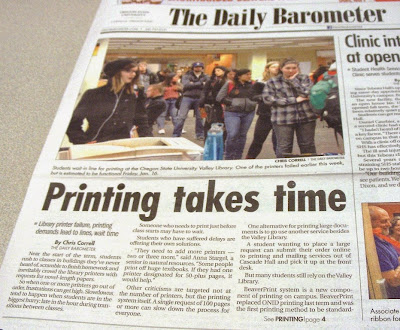PHOTO: Despite predictions for decades of a paperless computer future, computer printers are still in high demand at Oregon State University according to a, ironically, printed on paper student newspaper caption that says, "Students wait in line for printing at the Oregon State University Valley Library. One of the printers failed earlier this week, but is estimated to be functional Friday, Jan. 16," and article by Chris Correll, "Printing takes time," Oregon State University "The Daily Barometer," Jan. 16, 2015, p. 1, 4 posted Jan. 15, 2015.
I can clearly recall discussions decades ago, while attending printer business meetings for Hewlett-Packard, worrying about planning for the future of "paperless computing" because it would cause customers' demand for HP printers, ink and toner to diminish and the sales would drop. Decades later, while many things that were previously done exclusively on paper are now paperless, such as many manuals and documents for both products and services, it seems that the demand for printing things on paper hasn't diminished as much as was predicted or desired by those who want to save money or reduce the environmental impact of printing, especially in Oregon where the economy is dominated by the lumber and paper product industries. This is good for HP's printer business profits and my stock holdings, but it begs the questions of why is paper still needed and is there today even a greater environmental concern than before?
See previous post History of HP inkjet printers in American Heritage Invention & Technology (2/19/12) about the article I wrote: Thomas Kraemer, "Printing Enters the Jet Age, How today's computer printers came to eject microscopic dots with amazing precision," American Heritage Invention & Technology, Spring 2001, Vol. 6, No. 4, pp. 18-27 (PDF)
